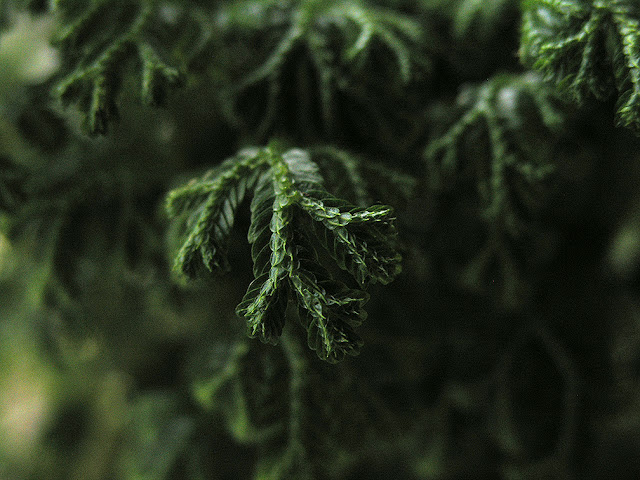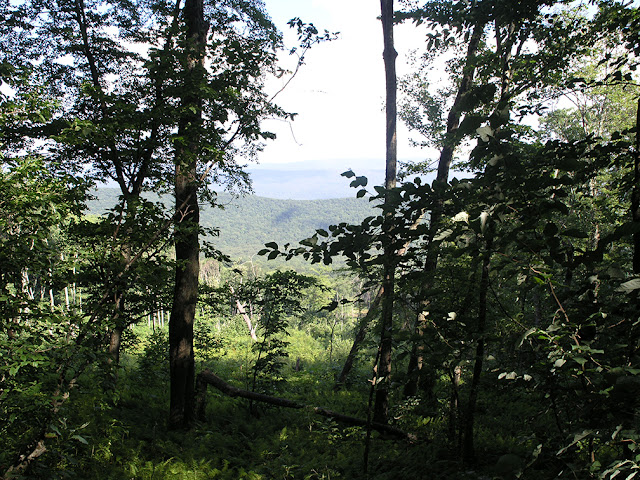 |
| Herb at a scenic overlook in West Virginia. |
Years ago I'd read that the
Dolly Sods Wilderness Area, at elevations ranging from 2500-4000 feet, had most unusual vegetation, more like what one would expect to find in Canada than our latitudes, and I'd been wanting to see it. The late summer weather has been so splendid recently, Saturday seemed like the perfect time to drive out to West Virginia to explore Dolly Sods.
Absorbed with preparing a picnic to take along, we left the house a bit later than planned--it was past noon. Clouds were gathering overhead as we drove west, but the weather forecast had not mentioned rain, so we hoped for the best. The road became steeper as the car began to climb over the first ridge on the horizon.
After about 25 miles we crossed the state line into West Virginia, driving through the small town of Wardensville. After that Route 48 became a scenic divided highway, crossing the Lost River. We stopped at one overlook for panoramic photos. Some miles past the South Branch of the Potomac River we took the exit towards Seneca Rocks and found ourselves on a two-lane country road once more. We passed picturesque Cabins and the Smoke Hole Caverns Resort, reaching the turn-off at Jordan Run Road. The first section of the road had only one lane open, the other was under construction--probably the result of a recent wash-out.
The sign for Dolly Sods appeared after a hairpin turn, pointing towards the left. The paved road soon became gravel and began to climb up the shoulder of the mountain, steeper and steeper as it wound upwards. Fabulous views began to open up amid clearings in the forest. At the top of the mountain the trees thinned out and the gravel road split in two. Seeing a car ahead to our right, we decided to follow.
 |
| The Wildlife Trail. |
We stopped to look at a signboard with trail maps; part of the map was pockmarked with what appeared to be shot gun pellets, but it gave no indication of where in that immense wilderness we were. I'd brought along a print of a similar trail map with me. We continued north on the road until we came upon a wider area with a few parked cars--this must be a trailhead, but which one?
A few steps inside the forest there was a sign: "Wildlife Trail." I located it on my map a saw that it was 1.5 miles long. The Fisher Spring Run trail intersected it, which seemed to lead back towards the forest road-- that would make a nice loop hike. We got on our gear and began walking--it was about four o'clock by now.
Ferns carpeted the open ground below the forest, with larger clearings here and there. I noticed that there were some birch trees that had large black growths in their trunks as if fire had scorched them--had there been a forest fire or was it some kind of fungus? If it was caused by fire, it was in a very selective pattern. I looked into this later and found that it's a fungus called
Chaga (
Inonotus obliquus) that grows in northern forests from Siberia on through Canada, which is credited with medicinal properties.
 |
| Bracket fungi and Chaga. |
 |
| Boneset (Eupatorium rugosum) growing profusely on the Wildlife Trail. |
There were quite a lot of fungi on the ground too, and the many muddy footprints on parts of the trail made evident the summer's earlier rains. Fortunately, the past couple of weeks weeks have been very dry and the mud had for the most part hardened. I noticed several old beeches by the side of the trail and thought to look for one of those odd saprophytes associated with old beech trees: beechdrops (
Epifagus virginiana) . Under these trees were some short brownish stems with small reddish-brown flowers. I'd never seen any plants like these before, these had to be beechdrops!
 |
| Beechdrops (Epifagus virginiana) |
 |
| Beechdrops on forest floor. |
What a lucky stroke! It was difficult to photograph them in the late afternoon light and most of my shots didn't turn out well. We continued our trek at a naturalist's pace, passing areas with undergrowth of clubmosses and spagnum moss.
 |
| Ground cedar (Diphasiastrum digitatum) |
|
 |
| Partridgeberry (Mitchella repens) growing among spagnum and other mosses. |
We traversed the first of the "sods"--a large open meadow where many Monarchs and other butterflies browsed on milkweed and goldenrod. We lingered to admire the butterflies and bees hovering at the edges of the sunlight.
 |
| Crossing the sods. |
 |
| Monarch butterfly in the sods. |
 |
Red Admiral butterflies.
|
Entering the forest again we were passed by a family with young children, the small boy very excited about seeing salamanders in a stream. We came to the stream and I turned over a few rocks to see if we could spot some salamanders but found none. We began to wonder about the other trail--hard to estimate without a pedometer, but it seemed we had walked at least a mile and a half by now and we should have come upon it.
 |
| Firs on the Wildlife Trail |
We pushed on, and eventually saw the other trail going off on the right. Steps going down hugged the side of the hill, but the bottom was invisible from here--we would likely have a steep climb back up to the other trailhead if we took this trail. With the afternoon waning it might be wiser to simply return on the same trail when we reached whatever point seemed prudent.
At the next turn we encountered three hikers on the way back, and asked them what the terrain ahead was like. They had started their hike from the southern end of Dolly Sods, on the Rohrbaugh Trail, and they mentioned that there was a lovely view down a canyon some ten minutes ahead. One elderly gentleman's accent and attire gave him away as foreign, probably a German tourist.
Herb was not too thrilled, but I insisted--having come this far, we should at least try to find the place. We crossed another large open meadow, the sun now lingering only at the eastern edge, and back into the woods. More club mosses of a different type on the ground, large Rhododendrons and we began to catch tantalizing glimpses of a view through the trees at the edge of a drop.
 |
| Club mosses on the forest floor. |
 |
| Glade with mountain laurel and blueberries. |
 |
| Rhododendrons in the glade. |
We entered an open glade with thick stands of mountain laurel and blueberry bushes where the view finally opened up. Standing at a rocky outcrop one could look down the "canyon"--a valley formed by the stream with several ranges of mountains disappearing in the distance--wow!
 |
| The canyon. |
With this as the highlight of our hike, despite my wish to linger, Herb set a forced-march pace for the return. I followed, gasping for breath, trying to keep up with his long stride. It had taken us two hours to get there, but at this pace we made it back to our car in about thirty-five to forty minutes. Of course, there was no time for any photos or even a glance at any plants. Herb was determined to get back down the mountain before it got dark.
 |
| Seneca Rocks seen from Dolly Sods. |
On the drive down Herb consented to one stop so I could take a few last shots of the mountains across the valley. We decided to have our picnic supper at dusk in a small park by the river that we'd seen on our way in near Cabins.
On the drive home a full moon was rising, peeking through clouds at first until it emerged to brightly light our way back (I found out later this was one of the "supermoons" of this fall, when the moon will be closest to the earth). The perfect end to a wonderful day!




















































